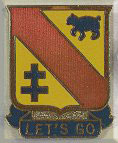
The story of Company D, 3rd Platoon, 1st Squad ...
After that we went to Camp Phillips, Kansas to prepare for overseas duty- were there when word came through of D day. We were jubilant since we thought the war will be over before we would see combat, and we would simply do occupation duty. We went to Camp Miles Standish, Mass. & shipped out from Boston on a brand new troop-ship(The General Gordon) in Sept-1944.
 troop-ship The General Gordon
troop-ship The General Gordon15 days later landed at Cherbourg, Normandy-where we saw the first of many devastations that war brings to people & real estate. Traveled by trucks to an apple orchard surrounded by hedge-rows near St. Germaine de Tournabut. On the trip we were pelted with apples thrown by the peasantry-some in friendship but some hard to hurt us if they could. We later found out the occupying German Army had many people friendly to them for various reasons-often inter marriage with local girls but in other cases because their treatment had been fair.
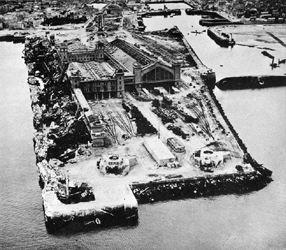 Destruction in the harbour of Cherbourg
Destruction in the harbour of CherbourgOn our truck ride to the Apple orchard bivuac area we passed through Carenten & Valognes both of which were in ruins. We mentioned to the locals about what a job our bombers had done, but to our suprise they corrected us by telling it was from our naval ships 25 or more miles away. While waiting for about a month before our introduction to combat we saw all the hidden concrete bunkers in the woods about the region -all with the signs of "Achtung-minen!!". .
 German warningsign for mine-fields
German warningsign for mine-fieldsWe were wary where we walked. We traveled to the front by 2 different modes. The majority were put on old French-"40 & 8s" and proceeded very slowly by rail line to the Area-"Foret de Parroy" near Luneville. The more fortunate ones, such as I, traveled by Jeep convoy which allowed for much more comfort and flexibility.
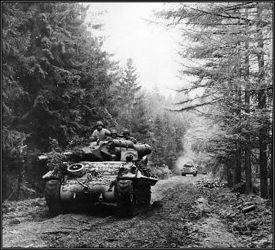 The Foret de Parroy near Luneville
The Foret de Parroy near LunevilleWhile waiting for a few days in the forest, we were informed that the Germans were in such dis-array that the troops we would engage with were called "stomack battalions" as they were grouped together because they were in such bad physical condition as to need special care & rations. We were in combat with them shortly & found out that had no basis in fact.We went into action at a small Village called-Embermenil. Actually just outside the town in an area of WW I trenches-which we used for protection from the constant shelling for the month we were in this defensive position.
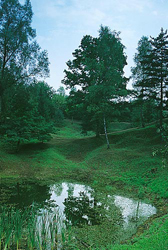 The WWI trenches near Embermenil (Fr)
The WWI trenches near Embermenil (Fr)After a month of sustaining many casualties while on defense we thought we were ready for taking the war to the Germans. The Generals obliged and on the 13th of October we began the big push. As should have been expected our casualties mounted, and getting enough replacements for those missing became a problem. I was in a foxhole in the positions just vacated by the enemy when a shell exploded knocking off my helmet & glasses and seriously wounding Vandy who was beside me. He was carried back to the aid station & ended up losing his leg.
After the war he came to our reunions but lost his life in a fire at his home due partly to his lack of mobility having only one leg.After an all night march thru woods-up and down small streams- we finally arrived at a hill side position-where the officers warned us we were behind the enemy lines and could expect to catch "hell" in the morning. As the experienced veterans we thought we had become we scratched a shallow hole and went to sleep. As dawn broke German shouts and machine gun fire broke our reverie and we began to fight each other to get to be the one in the relative safety of the deapening hole while the other would scrape the dirt aside lying prone on top. Finally in the early afternoon some P47s dive bombed & strafed the German tanks in the village of Avricourt just over the hill from us. We had heard the rumble of the tanks & knew we had no real defense against them, and so were grateful GIs for those "Fly-boys".
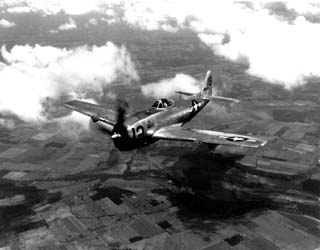 a P47 Thunderbolt, a fighter-bomber
a P47 Thunderbolt, a fighter-bomberAfter this we pushed thru the Saverne Gap-some of the outfit with the Free French forces took Strausburg on the Rhine- while we turned north fighting daily until we finally reached the Maginot & Siegfried Line positions in the Sarr region. We had crossed the Blies river into German territory-stayed on night when word was passed of a huge German attack up north and we withdrew back over the river and assumed defensive posture once again. It was well we did for after a week or so of constant check at night of our positions by "Bed check Charlie" as we called the German observation plane, we were attacked by men dressed in white - tanks & S.P. guns - the screaming Memmie Mortars and our counter fire soon exhausted our ammo supplies. We never gave ground though some of our Company men were captured and other division troops gave up some ground. After the war we heard this German offensive directed by H.Himmler and called "Operation Northwind", was intended to divide the Americans from the French forces and take back Strassburg.
Like the "Battle of the Bulge" it to was doomed to failure but only after much expenditure of "Blood-sweat & tears" by both sides. In the period before this we stayed over night in a Maginot Line concrete three story fortification. It had an underground railway system that connected the forts and we slept on a metal floor. It was the hardest sleeping bed I've ever experienced and tired as we were there was little sleep. After "Northwind" we were at rest for a time-got to take the luxury of a shower -then we traveled up to near the Rhine river where one morning we heard a continuous roar and saw streams of contrails that covered the sky from one horizon to the next. It was one of the thousand or more plane raids and gave one watching such a sense of overwhelming power and inevitableness that we gave up a silent prayer of thanksgiving that those were our planes & the eggs would be dropped on Germans.
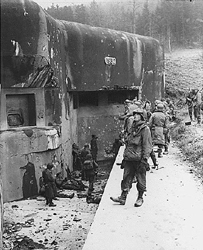 Bunkers of the formidable Maginot-Line
Bunkers of the formidable Maginot-LineWe crossed the Rhine at Worms detrucked and went back to combat driving down south toward Heidelberg. The Germans resisted every mile of the way but decided in the end to give up Heidelburg without a fight to preserve it for the future. Our next major task was to clear the enemy from the road down to Crailsheim taken by the 10th Amored Div. The Germans were "Panzerfausting" their supply vehicles and we went down both sides to clear them out. The 10th withdrew back thru us and drove westerly. When we got into Crailsheim we were greeted by dead bodies hanging-twisting from telephone poles. The civilians said they were their fellowtowns people who had been unfortunate enough to have Americans take over their homes-they had no choice in this of course-but when the SS returned any sign of American occupancy meant instant death.
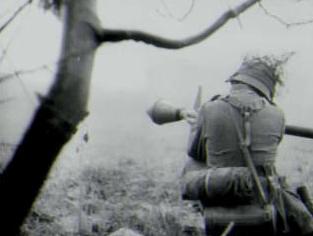 a German soldier with a panzerfaust
a German soldier with a panzerfaustAs it was clear by now the war was ending down & Germany would be defeated, such senseless killing was just another reason we were happy to have a hand in doing them in. After clearing Crailsheim we headed southwest toward Ulm on the Danube river. It was the largest city in which we fought. We had an opportunity to see what really tremendous distruction had been accomplished by our bombing planes to their cities though the Cathedral in the center of the town had little damage at all. The town citizens asked us why had the bombers continued to bomb the rubble even after the structures were completely destroyed. We could only say that Germany had started this type of detruction all over Europe and now they were being repaid in spades.
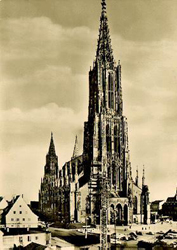 The Cathedral of Ulm
The Cathedral of UlmWe were quartered in a German Generals home on the northern edge of Ulm. After the war I read where Rommel lived in Ulm and it was from his home there he was forced to commit suicide. Have always wondered since if that was his home in which we stayed? From Ulm we crossed the Danube in pontoon boats and fought some resistence until we arrived at the railroad marshalling yards in the city of Kempten. On the way to Kempten we went beside the Iller river-thru Memmingen and ended up in Kemten where there was a large marshalling yard in the center of the city.
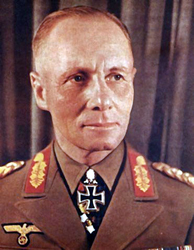 Feldmarschall Erwin Rommel
Feldmarschall Erwin RommelAfter taking over homes for our resting areas, we explored the town and found a real treasure on the rail lines. There were box-cars lined up and filled alternately with guns-ammo interspersed with some cars loaded with crates of bottles of German Army gin. What a find- and that evening the air was alive with guns being fired(mostly at the signs that glowed at dark and led down into the basement of some houses marked "Luftschutz-raum"-meaning air raid shelter. The combination of plenty of gin and guns is not a good mixture. Don't know if anyone was hit but bullets were flying everywhere as Jeeps loaded with "loaded" GI's shot up the town. We heard it the next day from our officers in no uncertain terms. Also we had freed many displaced people who had been forced to work for the Germans but when we told them they would now be free to go back home to Poland or Russia from whence most had come, we were suprised to learn they did not want that at all as conditions as "slaves" in Germany was preferable to conditions back home.
After a day or two we were told the next push was to be over the mountain passes & into Austria. It was now near the 1st of May-the weather was moderating and we looked forward to going thru the mountain passes and chasing the remaining Germans out of Austria and hopefully the wars end. We had heard that Hitler was dead so why would the Wehrmacht continue? Our route led thru Nesselwang to Fussen then down to Reutte where we located a SS headquarters and factory with much in the way of records of their infamous doings. Along about this time, Dr.Dornberger & Von Braun the main directors of the German rocket operations became captives of one of our units. Both were later instrumental in developing America's rocket program in Tenn.
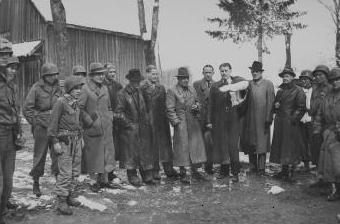 The capture of Werner von Braun
The capture of Werner von BraunOn we went to Lermoos then down the twisting Fern pass to a town called Nassereith -named for the town in Judea one presumes. These Austrian towns were quaint and colorful with balconies on each house decorated with flowers. Somehow incongerous with our mission and what was happening daily. Our artillery raked the hillslopes across from the road where we were stopped by sections blown out and resistance from ahead by machine gun and rifle fire. Also I remember a RR station which had a large sign reading "Trink COCA COLA" just like back in the states. We ended in a town on the Inn River called Landeck. On the 5th of May word came that the German 19th Army who had opposed us all the way to this point had surrenderd and our part in the war in Europe was over. Most shouted with joy-some knelt in prayer for it was truly our deliverance from evil.
 The Austrian town Landeck
The Austrian town LandeckOur Mortar platoon was stationed in an Austrian village, Strengen by the Inn river. We were in the Bürgermeister's house and part of his family was there with us. He had the insight to have sent his two teenage daughters to an upper level of the town which had 3 levels as much as a mile apart going up the mountain side. As we were the unit farthest down the road from Landeck and the first that the returning German troops had to come thru, we served as the drop off spot for any weapons they still had so we had a great chance for trophies to take home. I personally kept 5 P38 pistols and the best German Mauser rifle of the lot. It was called a Model 1924-which happened to be the year I was born. It's bolt stood out straight rather than curving down and the wooden stock was specially stained and polished. I was able to take it home in my duffle-bag and it hangs on the wall of my computer-medal room to this day.
The defeated Wehrmacht troops that came thru our check point were highly disciplined and all marched down the road in perfect step singing their army songs even "a-cappello". To an outside observer, we would have appeared as the defeated & the Germans as the victors. We remained on occupation duty-eventually going back by truck and railroad to camps in France over the channel to England and eventually all put on the Queen Elizabeth liner to New York on a quick 5 day passage.
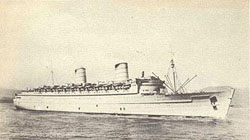 The Cunard White Star Superliner "Queen Elizabeth"
The Cunard White Star Superliner "Queen Elizabeth"Were greeted by water-boats spraying water and boats with people cheering us as we passed by the Statue of Liberty. We felt we should show some gesture of appreciation, so the GIs blew up hundreds on issued condoms for which we had found no use and floated them off the deck into eventually the water below. Wonder if the recepients of that gesture were aware of how we had obtained all those balloons. Marlene Dietrich greeted us at the dock as she had entertained us overseas during a rest period.
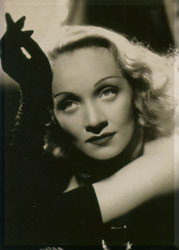 Marlene Dietrich ... an Angel in a war
Marlene Dietrich ... an Angel in a warClick the picture for the song "Lili Marleen" (English version)
We were stationed at Fort Smith, Ark. and I was home on leave on VJ day. Finally all was over we could go home-get married and rear a family and become humans once again.
Special thanks to Richard "Roddy" Rademacher and to Tim Blaise (nephew of Francis Blaise)